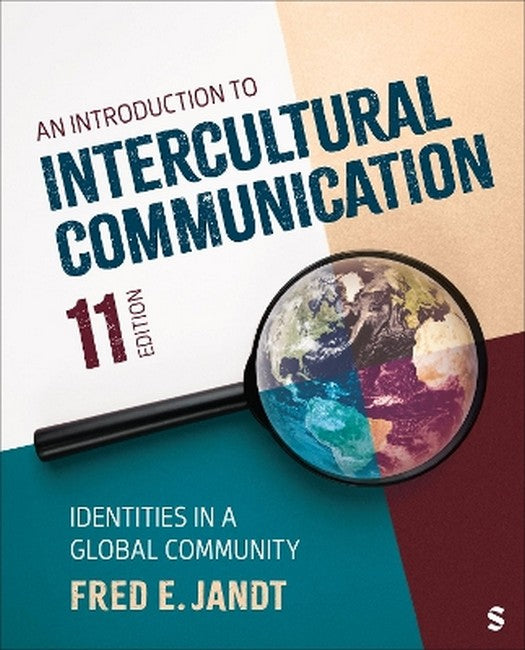Fred E. Jandt was born of second-generation German immigrants in the multicultural south-central region of Texas. After graduating from Texas Lutheran University and Stephen F. Austin State University, he received his doctorate in communication from Bowling Green State University. He has taught and been a student of intercultural communication for more than 4 decades, developing his experience through travel and international training and research projects. While professor of communication at The College at Brockport, State University of New York, his reputation as a teacher led to his appointment as SUNY's first director of faculty development. He has retired as professor and branch campus dean after having been named outstanding professor. He has also been a visiting professor at Victoria University of Wellington, in New Zealand. He has extensive experience in the areas of intercultural and international communication, negotiation, mediation, and conflict management. He was one of the first scholars to introduce the study of conflict to the communication discipline with his text Conflict Resolution Through Communication (Harper & Row, 1973). He has subsequently published many other titles in this area, including the successful trade book Win-Win Negotiating: Turning Conflict Into Agreement (Wiley, 1985), which has been translated into eight languages; a casebook on international conflict management, Constructive Conflict Management: Asia-Pacific Cases (SAGE, 1996), with Paul B. Pedersen; Conflict and Communication, Third Edition (Cognella, 2025); and Negotiation and Mediation (Cognella, 2025). For several years, he conducted the training workshop "Managing Conflict Productively" for major corporations and government agencies throughout the United States. Jandt continues to train volunteers who are learning to become mediators in the California justice system and served as an elected trustee of the Desert Community College District.
Request Academic Copy
Please copy the ISBN for submitting review copy form
Description
WHY Study Intercultural Communication With This Textbook? Acknowledgments About the Author Part 1 Culture as Context for Communication 1 Defining Culture and Communication Sources of Identity Culture Cultural Definitions of Communication The Media of Intercultural Communication Discussion Questions 2 Intercultural Communication Competence Perceptual Barriers to Intercultural Communication Learned Barriers to Intercultural Communication Communicating Racism Overcoming Barriers Identities and Intercultural Competence Intercultural Communication Ethics Discussion Questions Part 2 Communication Variables 3 How Culture Affects Perception Sensation Perception High Versus Low Context Communication Between High- and Low-Context Countries: China and the United States Current Issues in Chinese-U.S. Relations Discussion Questions 4 Nonverbal Communication Approaches to the Study of Nonverbal Behavior Nonverbal Communication Functions Types of Nonverbals Associated With Our Bodies Other Nonverbals We Use to Communicate Nonverbals in Cultural Context Discussion Questions 5 Language as a Barrier Sapir-Whorf Hypothesis Translation Problems Pidgins, Creoles, and Constructed Languages Language as Nationalism The Spread of English Discussion Questions Part 3 Cultural Values 6 Nation-State Cultural Values Major Models of Cultural Values Criticisms of and Responses to Cultural Values Research Cultural Constructs Related Constructs Singapore and Japan Case Studies DISCUSSION QUESTIONS 7 U. S. Values and Identity Origins of U.S. Cultural Patterns Value Orientation Theory DISCUSSION QUESTIONS 8 Religion and Identity The World's Religions Dominant Cultural Patterns in the Arab States Saudi Arabia Case Study Arab States and U.S. Intercultural Challenges DISCUSSION QUESTIONS 9 Culture and Gender Status of Women Comparison of Individual Countries and Regions Nonbinary Gender Identities Gender Expression and Communication DISCUSSION QUESTIONS Part 4 Cultures Within Cultures 10 Migration and Acculturation A World of Travel and Migration Culture Shock Acculturation Immigration and National Identity Immigration and the United States Discussion Questions 11 Communities Marginalization Separation Assimilation Integration Hispanic Culture Within the U.S. Culture Discussion Questions 12 Identity and Communities Community Language and Media Examples of Communities Sexual and Gender Communities Sexual and Gender Communities and Othering Redefining Sexual and Gender Communities Discussion Questions Part 5 Applications 13 The Impact of Cultures on Other Cultures Colonialism and Imperialism Development Communication Cultural Icons Glocalization Cultural Hegemony Discussion Questions 14 Future Challenges Challenges to Sources of Identity Future Challenges to Identity A Final Word Discussion Questions
This text provides a balanced, comprehensive examination of theory and practice of intercultural communication with a blend of contemporary and classic sources. -- Janie M. H. Fritz Fred Jandt has an excellent track record in the field of communication studies and this textbook bolsters that reputation. It is current, wide ranging, and pedagogically sound. -- Shawn Queeney Jandt's book not only reveals the history of communication in a global context, but it strives to keep with trends in society. The book introduces intercultural competencies and barriers to students. It helps students think about the whole versus the individual. -- Stefanie Leiter An Introduction to Intercultural Communication offers real-world perspectives on cultural and intercultural communication, to include micro and sub-cultures within dominant cultures. It is rich with real-world experiences that reveal similarities and differences between cultural entities. Finally, this text offers a depth of content that fosters conversation and discussion of issues relevant to cultural communication. -- Terilyn J. Goins

